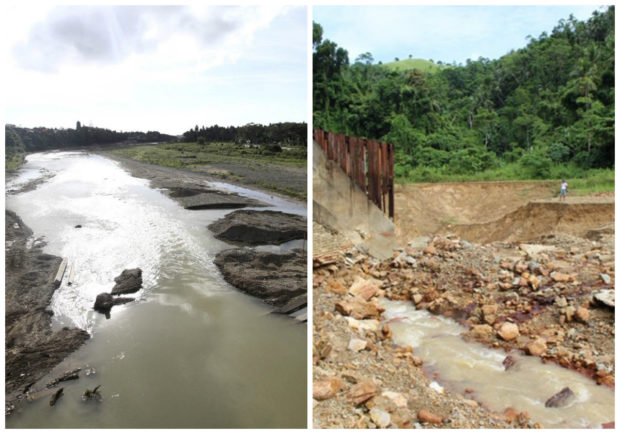
MINE TRAGEDY The 1996 Marcopper mine accident spelled doom for the Boac River, nowa dead and heavily silted waterway. At right, an environmental group says the abandoned Maguila-guila Damin Mogpog town never served its purpose to stop river siltation. (Photos by RICHARD A. REYES and MARINDUQUE COUNCIL FOR ENVIRONMENTAL CONCERNS
A heavily silted Mogpog River, groaning under “hundreds of millions” of tons of low-grade ore and mine tailings, has caught the government’s attention anew, as local officials and a civil society group underscore the much-needed rehabilitation of Marinduque province’s river system.
Years of heavy rainfall and surface runoff have caused heavy siltation in the Mogpog River that cuts through 13 villages in Mogpog town.
Most parts of the river have now become too shallow to hold water, resulting in massive flooding in nearby communities during typhoons.
“It is a dead river,” said Rommel Fernandez, Marinduque’s provincial legal officer.
Mountain of waste
Like its twin, the Boac River, which passes through the capital Boac town, the Mogpog River drains into the Tablas Strait. Upstream, it leads to the San Antonio pit, which used to be a mine depository of the defunct Marcopper Mining Corp.
Several issues arise from the abandoned pit that has now become a mere “mountain of waste” on the verge of collapse.
“It is mountain-like, an accumulation of low grade ore,” said Roland de Jesus, director of the Mines and Geosciences Bureau (MGB) in Mimaropa (Mindoro, Marinduque, Romblon and Palawan) region, referring to rocks from which minerals, like copper, have yet to be extracted.
But Elizabeth Manggol of the nongovernment Marinduque Council for Environmental Concerns (Macec) said the San Antonio dump also contained toxic mine tailings.
During Marcopper’s operation, the company had constructed the Maguila-guila Dam to collect mine waste from the San Antonio pit and prevent its spill-off into the Mogpog River and into the sea.
But the dam partly gave way in December 1993, three years prior to the 1996 major mine accident when Marcopper’s drainage tunnel burst, unleashing at least 200 million tons of tailings into the Boac River.
The 1996 accident forced the Canadian firm to shut its operation in the Philippines.
The Marinduque government had filed a multimillion-dollar lawsuit against Marcopper, only to see the case thrown out by a court in the United States for reasons of technicality.
Environment Secretary Roy Cimatu said he would issue a department administrative order to place the Mogpog and Boac rivers under rehabilitation, once the Department of Environment and Natural Resources (DENR) received a formal request from the provincial government.
“The environmental damage and unresolved issues brought about by the Marcopper mining operation in Marinduque for several decades now must be put to an end,” he said during the centennial celebration of the province last month.
Long-term solutionsCimatu said the planned river rehabilitation would include the dredging of the two rivers by a private contractor at no cost to the government. The contractor, he said, would shoulder all the expenses in exchange for whatever minerals it would recover, provided that it would pay the corresponding excise tax.
De Jesus said the mine tailings in the Boac River had already settled underwater that dredging, should it be an option, requires a careful environmental study.
“The [Maguila-guila Dam] never served its purpose to prevent the [river] siltation. [The structure] is still there but as the MGB had said, it is in its worse condition,” Manggol said, as her group called on the government for “long-term solutions.”
In recent years, the MGB had traced “leaks” on the Maguila-guila Dam.
“It’s full to the brim. It’s not working [as a dam] anymore because of nonmaintenance,” De Jesus said.
The provincial government in February formed a technical working group with the MGB and Macec to review its legal options and to come up with recommendations, among them river dredging and the construction of a gabion dam.
The 90-meter wide gabion dam, to be constructed 2 kilometers from Maguila-guila, is just a “stopgap” measure to filter the debris from spilling into the rest of the Mogpog River, the DENR said.
Cimatu had recently approved the release of P5 million to jumpstart the river restoration, although this was only intended for technical studies.
“The actual construction [of a gabion dam] will cost millions of pesos,” De Jesus said. —WITH A REPORT FROM JHESSET O. ENANO